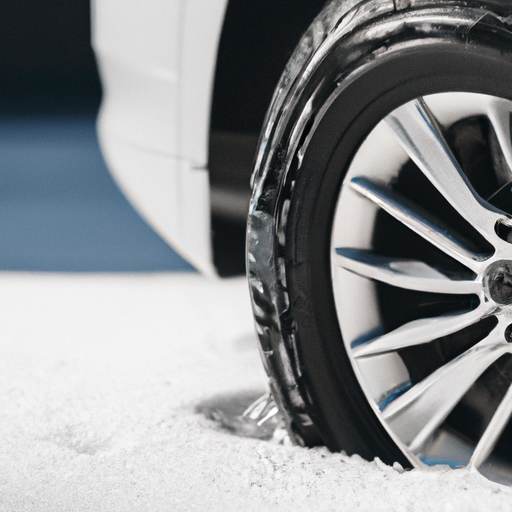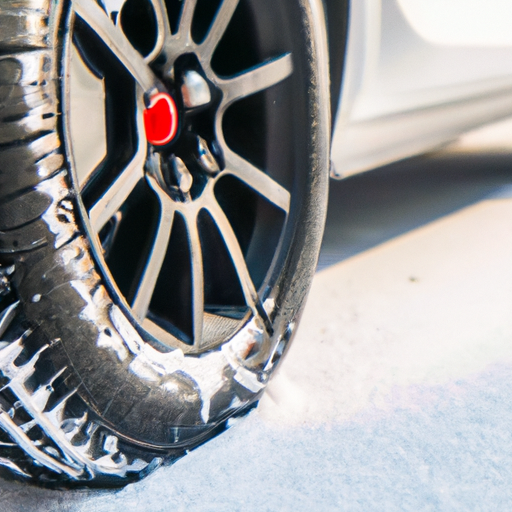When it comes to selecting winter wheels, there are a few key factors that you should keep in mind. First and foremost, consider the climate and road conditions in your area during the winter months. Additionally, think about the type of vehicle you own and its specific requirements. It’s also important to consider your driving habits and the level of performance you expect from your wheels. By carefully considering these factors, you can ensure that you choose the perfect set of winter wheels to keep you safe and secure on the road during the chilly season.

Material
When it comes to choosing winter wheels, one of the first factors to consider is the material. There are three main types of materials used in winter wheels: alloy, steel, and composite.
Alloy
Alloy wheels are made from a combination of aluminum and other metals, making them lightweight and strong. Their lightweight nature can help improve fuel efficiency and overall vehicle performance. They are also highly resistant to corrosion, making them a durable option for winter driving. Additionally, alloy wheels tend to have a more attractive, sleek appearance compared to other materials.
Steel
Steel wheels are a popular choice for winter driving due to their affordability and durability. They are less likely to be damaged by road hazards such as potholes, and their strength can withstand harsh winter conditions. While steel wheels may lack the aesthetic appeal of alloy wheels, they are a practical choice for those looking for a budget-friendly option.
Composite
Composite wheels are a relatively newer option in the market. These wheels are made from advanced composite materials, such as carbon fiber or fiberglass, which offers a unique combination of strength and lightweight properties. Composite wheels can provide enhanced performance and handling, but they can also come at a higher price point compared to alloy or steel wheels.
Size
Size plays a crucial role in choosing the right winter wheels for your vehicle. It is important to consider three key factors: diameter, width, and offset.
Diameter
The diameter of a wheel refers to the distance between two opposite points on the rim, usually measured in inches. It is crucial to choose the correct diameter size that is compatible with your vehicle’s specifications. Choosing the wrong diameter can lead to improper fitment, affecting the overall performance and safety of your vehicle.
Width
Wheel width refers to the distance between the inner and outer flanges of the rim. It is essential to consider the recommended width for winter tires to ensure proper support and stability. Choosing the appropriate width allows for optimal contact with the road surface, providing better traction and handling in icy and snow-covered conditions.
Offset
The offset of a wheel determines the position of the mounting surface relative to the centerline of the wheel. It is important to select the correct offset for your vehicle to ensure proper alignment and clearance. Improper offset can lead to rubbing against suspension components or fenders, which can cause damage to your vehicle.
Design
The design of winter wheels not only affects the aesthetics of your vehicle but also plays a role in the performance and functionality. There are two key aspects to consider when it comes to wheel design: spoke configuration and finish.
Spoke Configuration
The spoke configuration refers to the number, shape, and arrangement of the spokes in the wheel. Each configuration offers its own benefits and considerations. For winter driving, it is advisable to choose a wheel with fewer, thicker spokes as they provide better structural integrity and are less prone to damage from road debris or snow buildup.
Finish
Wheel finishes can range from glossy to matte, and each finish has its own unique aesthetic appeal. However, when choosing winter wheels, it is important to consider a finish that is not only visually appealing but also provides adequate protection against harsh winter conditions. Opting for a finish that is highly resistant to corrosion and salt damage can help prolong the lifespan of your winter wheels.
Weight
The weight of a wheel may not seem like a significant factor, but it does impact the overall performance of your vehicle. Lightweight wheels can help improve acceleration, braking, and overall handling, especially in winter driving conditions. However, it is important to strike a balance between weight reduction and durability, as excessively lightweight wheels may not be able to withstand the rigors of winter driving.
Compatibility
When choosing winter wheels, considering the compatibility with your vehicle is essential to ensure a proper and safe fit. There are three key aspects of compatibility to keep in mind: vehicle make and model, bolt pattern, and hub bore size.
Vehicle Make and Model
It is crucial to choose winter wheels that are specifically designed to fit your vehicle make and model. Different vehicles have varying wheel specifications, and using incompatible wheels can lead to improper fitment, affecting the overall performance and safety of your vehicle. Consult your vehicle’s manual or reach out to a professional to ensure you choose the correct wheels for your specific make and model.
Bolt Pattern
The bolt pattern refers to the number of bolts on the wheel and the distance between them. It is essential to select winter wheels with a bolt pattern that matches your vehicle’s specifications. The correct bolt pattern ensures that the wheels are securely fastened to the vehicle, preventing any potential safety hazards while driving.
Hub Bore Size
The hub bore size is the diameter of the central hole in the wheel hub. It is important to choose winter wheels with a hub bore size that matches your vehicle’s hub size. Doing so ensures proper centering of the wheels on the hub, allowing for even weight distribution and optimal wheel performance.

Tire Type
Choosing the right tire type for your winter wheels is crucial to ensure optimal performance and safety in various winter driving conditions. There are three main types of winter tires to consider: studless, studdable, and performance.
Studless
Studless winter tires are designed with specially formulated rubber compounds and deeper tread patterns. They provide excellent traction on snow and ice without the need for metal studs. These tires are ideal for areas with frequent snowfall and icy road conditions as they offer superior grip and stability.
Studdable
Studdable winter tires are designed with holes that allow for the insertion of metal studs. The studs provide enhanced traction and grip on icy surfaces. Studdable tires are a good option for those who frequently encounter severe winter conditions, but it is important to note that some regions have restrictions on the use of studded tires due to the potential damage they can cause to road surfaces.
Performance
Performance winter tires are designed for those who prioritize handling and responsiveness in winter driving conditions. These tires offer improved grip on cold, dry pavement and are suitable for areas where snowfall is less frequent. Performance winter tires strike a balance between winter traction and enhanced handling characteristics.
Industry Certifications
When choosing winter wheels, it is important to consider industry certifications as they can provide reassurance of the quality and performance of the product. Look for the following certifications:
TUV
TUV certification is a well-recognized mark of conformity for automotive components. It ensures that the product has undergone rigorous testing and meets the required standards in terms of safety, performance, and durability. Products with TUV certification have been proven to meet European safety regulations.
ISO
ISO certification confirms that the manufacturer follows internationally recognized standards for quality management systems. It ensures that the products are consistently produced and meet customer requirements. Choosing winter wheels with ISO certification provides confidence in their reliability and quality.
DOT
DOT certification is a requirement for all tires sold in the United States. It ensures that the tires meet the minimum requirements for performance and safety set by the Department of Transportation. Checking for DOT certification when choosing winter wheels ensures that the product meets the necessary standards for road use.

Budget
Consider your budget when choosing winter wheels as it will help narrow down your options. Winter wheels can vary significantly in price, depending on the material, design, and brand. Setting a price range that aligns with your budget will help ensure you find a suitable option without breaking the bank.
Price Range
Winter wheel prices can vary from budget-friendly options to high-end premium wheels. Consider your budget and prioritize the features that are most important to you. Keep in mind that while higher-priced wheels may offer additional benefits such as improved performance or aesthetics, there are often affordable options available that provide satisfactory performance for winter driving.
Long-Term Value
When considering the budget for your winter wheels, it is important to think beyond the initial purchase price. Evaluating the long-term value involves considering factors such as durability, warranty coverage, and potential cost savings from improved performance or fuel efficiency. Investing in quality winter wheels that offer long-term value can save you money in the long run by reducing the need for frequent replacements or repairs.
Driving Conditions
Understanding the specific driving conditions you will encounter during the winter season is crucial when choosing the right winter wheels. Different regions have varying weather patterns, which can greatly influence the performance requirements of your wheels. Consider the following driving conditions:
Snow & Ice
If you live in an area with heavy snowfall and icy road conditions, it is essential to choose winter wheels that are specifically designed to provide maximum traction and grip in these conditions. Look for wheels with deep snow channels and specialized rubber compounds for optimal performance on snow and ice.
Dry Pavement
In regions where snowfall is less frequent, but cold temperatures prevail, it is important to consider winter wheels that can handle dry pavement conditions. Look for tires that offer good cold-weather performance without compromising on dry surface handling and responsiveness.
Mixed
If the driving conditions in your area vary between snowy, icy, and dry, it is advisable to choose winter wheels that can perform well in a wide range of conditions. Look for tires with a versatile tread pattern that provides good traction on snow and ice, while still offering stability on dry pavement.

Maintenance
Proper maintenance of your winter wheels is essential to ensure optimal performance and longevity. There are a few key areas to focus on when it comes to wheel maintenance: cleaning, storage, and seasonal changeover.
Cleaning
Regularly cleaning your winter wheels is important to remove road salt, grime, and other debris that can build up during winter driving. Use a non-abrasive wheel cleaner and a soft brush or sponge to clean the wheels. Avoid using harsh chemicals or abrasive materials that can damage the finish.
Storage
When winter is over, proper storage of your winter wheels can help prevent damage and prolong their lifespan. Clean the wheels thoroughly before storing them and consider using wheel covers or storing them in protective bags. Choose a dry, cool, and well-ventilated area to store the wheels to prevent corrosion or any other type of damage.
Seasonal Changeover
Changing your winter wheels to summer or all-season ones requires proper care and attention. Ensure that the wheels are properly balanced and aligned before installation. Check for any signs of damage or wear, such as cracks or uneven tread wear, as this may indicate the need for replacements. Additionally, consult the manufacturer’s guidelines for proper installation and torque specifications.
Warranty
Considering the warranty offered with your winter wheels is important to have peace of mind and protect your investment. Manufacturers often provide different types of warranty coverage, durations, and terms, so be sure to inquire about these details before making a purchase.
Coverage
Review the warranty coverage to understand what aspects of the wheel are covered, such as manufacturing defects, structural integrity, or finish damage. Some warranties may also cover roadside assistance or prorated replacement in case of damage or failure.
Duration
Take note of the duration of the warranty, as it can vary from one manufacturer to another. Longer warranty periods indicate the manufacturer’s confidence in the durability and quality of their product.
Terms
Read and understand the terms of the warranty, including any conditions or limitations that may apply. Some warranties may require regular maintenance or proper installation to remain valid. Be aware of any exclusions or circumstances that may void the warranty.
By considering these various factors and taking the time to research and choose the right winter wheels for your vehicle, you can ensure a safe and enjoyable driving experience during the winter season. Remember to consult with professionals or refer to your vehicle’s manual for specific recommendations that align with your vehicle’s make and model. Stay prepared and drive confidently on winter roads with the right set of winter wheels. Stay safe and enjoy the winter wonderland!


